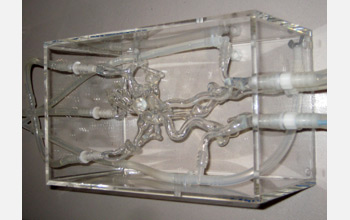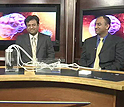Media Advisory 10-015
NSF Webcast: Getting a Grip on Stroke Treatment
Innovators present new device for removing blood clots in the brain

The modeled environment for testing Insera's blood-clot removal device is shown here.
May 19, 2010
View a webcast featuring the SHELTER technology and its developers Vikram and Vallabh Janardhan.
This material is available primarily for archival purposes. Telephone numbers or other contact information may be out of date; please see current contact information at media contacts.
A new surgical device--tested using silicone copies of human cadaver blood vessels--is poised to advance stroke treatment and revolutionize how the medical community evaluates new technologies.
On Thursday, May 27, at 2:00 p.m. EDT, during a webcast hosted by the National Science Foundation, the developers of the net-like Insera SHELTERTM device will demonstrate how their technology filters and removes blood clots, and present the latest results from recent performance tests.
Interventional neurologist Vallabh Janardhan and Insera engineer and CEO Vikram Janardhan will explain how SHELTERTM (which stands for Stroke Help using an Endo-Luminal Transcatheter Embolus Retrieval device) may be a safer alternative to the common "corkscrew" approach for strokes, which can release stroke-inducing debris. The researchers will also describe their uniquely accurate testing platform, one nearly identical to living human tissues--complete with aneurisms, atherosclerosis and "plaque"--which may supplant certain types of animal testing experiments.
| Who: | Interventional neurologist Vallabh Janardhan and engineer Vikram Janardhan of Insera Therapeutics of Sacramento, Calif. |
| What: | Webcast demonstration of NSF Small Business Innovation Research (SBIR)-supported Insera SHELTERTM device. |
| When: | Thursday, May 27, 2010, at 2:00 p.m. EDT |
| Where: | Media are invited to participate in the webcast by phone or online at http://science360.gov/live/. (Note: the URL will only be live during the event.) Please contact Josh Chamot (jchamot@nsf.gov) for phone number and passcode information. Vallabh and Vikram Janardhan will respond to questions from the media throughout the webcast. |
Questions before and during the webcast can be directed to webcast@nsf.gov. May is National Stroke Awareness Month; learn more on the Centers for Disease Control and Prevention website. Insera is supported by NSF SBIR grant 0946099.
-NSF-
-
View Video
On May 27, 2010, NSF hosted a webcast featuring the SHELTER technology and its developers.
Credit and Larger Version
Media Contacts
Joshua A. Chamot, NSF, (703) 292-7730, email: jchamot@nsf.gov
Program Contacts
Gregory T. Baxter, NSF, (703) 292-7795, email: gbaxter@nsf.gov
Principal Investigators
Vallabh Janardhan, Insera Therapeutics, (916) 849-0945, email: vallabh@inseratherapeutics.com
Co-Investigators
Vikram Janardhan, Insera Therapeutics, (916) 849-0945, email: vikram@inseratherapeutics.com
The U.S. National Science Foundation propels the nation forward by advancing fundamental research in all fields of science and engineering. NSF supports research and people by providing facilities, instruments and funding to support their ingenuity and sustain the U.S. as a global leader in research and innovation. With a fiscal year 2023 budget of $9.5 billion, NSF funds reach all 50 states through grants to nearly 2,000 colleges, universities and institutions. Each year, NSF receives more than 40,000 competitive proposals and makes about 11,000 new awards. Those awards include support for cooperative research with industry, Arctic and Antarctic research and operations, and U.S. participation in international scientific efforts.
Connect with us online
NSF website: nsf.gov
NSF News: nsf.gov/news
For News Media: nsf.gov/news/newsroom
Statistics: nsf.gov/statistics/
Awards database: nsf.gov/awardsearch/
Follow us on social
Twitter: twitter.com/NSF
Facebook: facebook.com/US.NSF
Instagram: instagram.com/nsfgov



